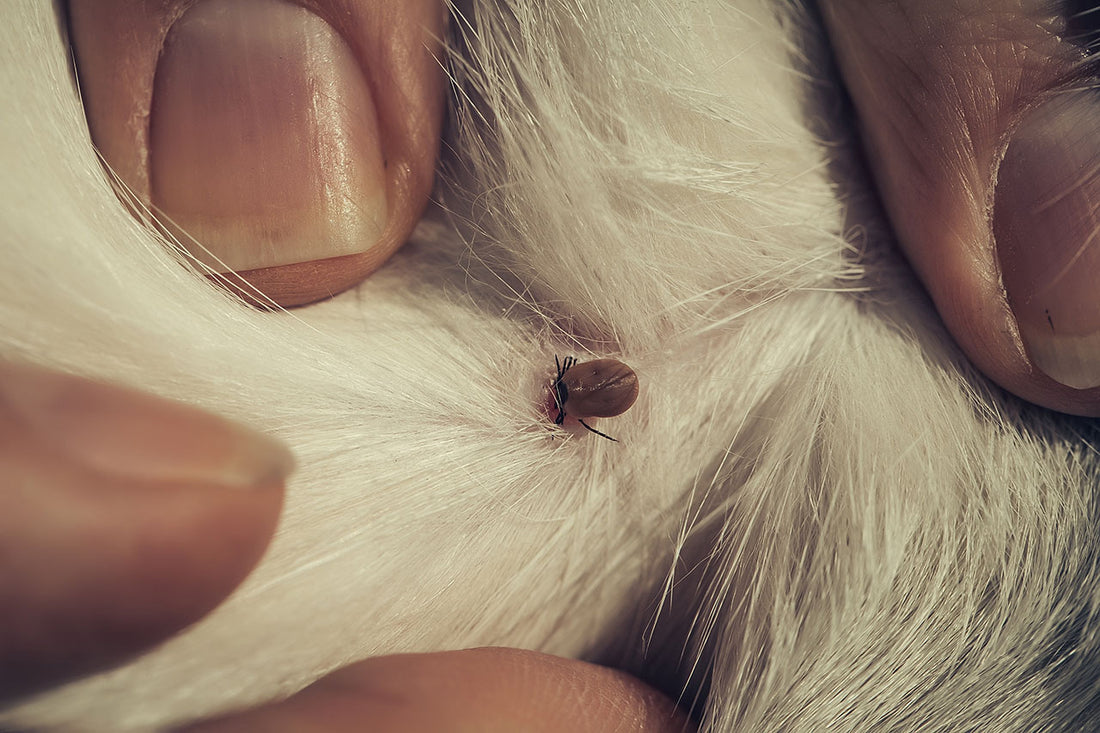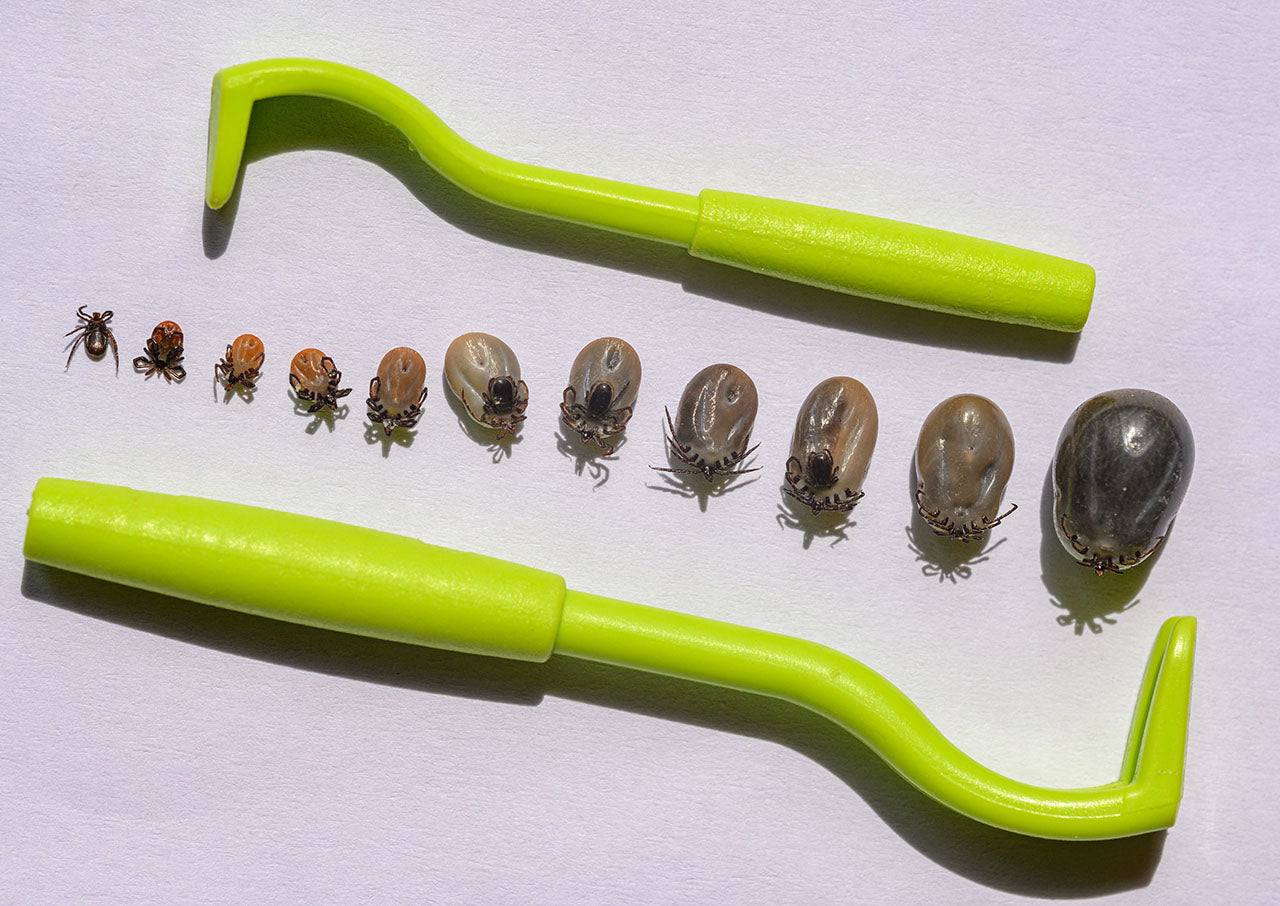Every year it comes back to… the annoying topic: ticks.
But not all ticks are the same.
Ticks are classified as ectoparasites. Ectoparasites are "external parasites". As the name suggests, they attack their host from the outside and not from the inside.
But did you know that there are different types of ticks?
Firstly, ticks are divided into hard ticks and leather ticks. In contrast to leather ticks, the mouthparts of hard ticks are visible from above. Hard ticks are the most common in Central Europe. They have a pronounced chitin shield with a pattern on their back. In male ticks, this shield covers the entire back. Female ticks, on the other hand, have a smaller dorsal shield that only covers the front third. This gives the female tick enough space to ingest blood and lay her eggs.
The most common tick species in our country is the common tick (Ixodes ricinus). The tick is up to 4 mm long, with females being larger than males. They prefer moist, warm environments such as forests and meadows and are found in vegetation close to the ground. They wait for their hosts and allow themselves to be brushed off by them.
The floodplain tick (Dermacentor reticulatus) is increasingly found in our region. The meadow tick is slightly larger than the common tick and has a dorsal shield with a white marbled pattern. In contrast to the tick, the meadow tick actively searches for food.
The Brown dog tick (Rhipicephalus sanguineus) is particularly common in southern Europe, but can also thrive in warm homes. So be careful if you are spending your holiday in southern Europe with your four-legged friend.
life cycle of a tick
Ticks are arachnids and have 8 legs when fully grown. The life cycle of a tick includes four stages: egg, larva, nymph and adult tick. They undergo a metamorphosis that is typical for most tick species.
- Egg: The life cycle begins when a female tick lays eggs after a blood meal. These eggs are usually laid in moist, shady areas such as leaf litter or grass. A female tick can lay hundreds to thousands of eggs.
- Larva: After a few weeks, the eggs hatch and turn into larvae. The larvae have only six legs and are very small. They then begin to search for a host animal from which they can suck blood in order to feed. Most larvae feed on small mammals or birds.
- nymph : After the larvae have enjoyed a blood meal, they shed their skin and become nymphs. Nymphs already have eight legs and resemble adult ticks, but are smaller. Like larvae, nymphs also search for a host animal to feed on. They usually prefer larger hosts than larvae.
- Adult tick: After the nymphs have fully developed, they shed their skin again and become adult ticks. Male and female adult ticks now search for a host to mate and feed on. After mating, female ticks lay eggs again and the cycle begins again.
The sucking process lasts 3 - 12 days, depending on the tick's stage. Under optimal conditions, a tick develops in about 178 days. However, the life cycle of a tick can also last up to four years, depending on environmental conditions such as temperature and humidity. The main activity times for ticks are from March to October, depending on the weather conditions.
Tick sting or tick bite?
Most people use the term "tick bite". This term is more common, but from a scientific point of view it is still incorrect. The correct term is "tick sting".
Ticks have a proboscis with which they suck blood and two small, scissor-like tools on their mouths. They use these to open the skin of their host to get to a good place to bite. They then pierce the tissue with their proboscis and suck blood over several days. So it is not a tick bite, but a tick sting.
What diseases can ticks transmit?
There are a number of diseases that can be transmitted from ticks to dogs and can be life-threatening. These include:
Lyme disease : Caused by the bacteria Borrelia burgdorferi. Symptoms can include joint pain and paralysis. In advanced cases, Lyme disease can lead to more serious health problems, such as kidney failure, heart problems, or brain damage.
anaplasmosis : This disease is caused by bacteria of the genus Anaplasma. Symptoms include fever, lameness, diarrhea and vomiting.
ehrlichiosis : Caused by bacteria of the genus Ehrlichia that attack the white blood cells. Symptoms include fever, coughing up blood, swollen lymph nodes, fatigue, loss of appetite and joint pain.
babesiosis : Infection of red blood cells by Babesia and rapid proliferation. Symptoms include high fever, loss of appetite, weakness, jaundice, dark urine and epilepsy.
Not all ticks are infected with pathogens and not all tick bites result in disease. However, preventing tick bites in dogs is crucial to minimizing the risk of disease. This includes regularly checking the coat for ticks, using tick repellent products and, if necessary, vaccinating against certain diseases. If your dog shows signs of a tick-borne disease, he should be examined and treated by a veterinarian immediately.
How do I protect my dog from ticks?
There are several measures you can take to protect your dog from ticks:
- Use of tick repellent products : There are a variety of products on the market to repel ticks. These include, for example, tick sprays , spot-on preparations, collars and tablets. These products often contain active ingredients such as isoxazolines, pyrethroids or macrocyclic lactones, which can repel and/or kill ticks. Caution is advised when using macrocyclic lactones in dogs with MDR1 defects.
- Regular check-ups : After walks outside, you should check your dog's fur thoroughly for ticks. It is especially important to look in places like the ears, between the toes, under the armpits and around the stomach, as these are the places ticks prefer to visit.
- vaccinations Vaccines against certain tick-borne diseases are available in some areas. Check with your veterinarian to see if such vaccinations are recommended for your dog.
- environmental management : Keep your yard clean and tidy by mowing tall grass, removing undergrowth and clearing piles of leaves, as these areas provide ideal habitats for ticks.
- Natural tick repellent : Some dog owners also use natural remedies based on essential oils (lemongrass oil, lavender oil) to deter ticks or are convinced by the effect of coconut oil or black cumin oil A natural repellent against ticks would be, for example, ZeckAttack tick repellent by alphazoo.
By combining these measures and applying them regularly, you can significantly reduce the risk of tick bites in your dog and protect him from tick-borne diseases. It is best to seek individual advice from your veterinarian about which protection and active ingredient is best for your four-legged friend. Good tick protection should be extremely important to you for the well-being of your four-legged friend, because every tick bite is one too many.
Of course, you should not forget your own tick protection.
How do you remove a tick?
Removing ticks from dogs requires caution to ensure that the tick body is completely removed. Here is a step-by-step guide on how to safely remove ticks from your dog:
- Preparation: Make sure you have the right tool to safely remove the tick. This can be tweezers, special tick pliers, a tick hook or a tick card, depending on your personal preference. You can get all of these at most pet stores or online.
- Put on gloves: Wear disposable gloves to protect yourself from possible infections.
- Finding a tick: Examine your dog's coat carefully and look for ticks. They can attach themselves to warm, hidden places on your dog's body, such as on and in the ears, around the eyes, under the armpits and around the stomach.
- Removal of the tick: Once you've found a tick, take your favorite tick removal tool and place it as close to your dog's skin as possible, just above the tick. Gently squeeze the pliers or hook and pull the tick out slowly and evenly. Be careful not to squeeze or twist the tick's body, as this can cause the tick to become stressed and release disease-causing saliva. After removing the tick, check to make sure it is complete and that the mouthparts have been removed from the skin.
- Disposal of the tick: Dispose of the removed tick safely by placing it in a sealed container, drowning it in alcohol, or burning it to ensure it is killed.
- Disinfection: Disinfect the bite site and your hands with a non-burning disinfectant.
- Observation: Monitor your dog's bite site over the next few days/weeks for signs of infection or inflammation. If you notice any unusual changes, contact your veterinarian.
It is important to remove ticks as soon as possible to minimise the risk of disease transmission. If you are unsure or have difficulty removing the tick, it is best to contact your veterinarian who can help you if necessary.
Did you know?
Ticks have a sense of smell with which they can smell skin odors (butyric acid, CO2) and perceive their hosts.
tick myth
Did you have to wear a hat in the woods to protect your head from ticks falling down? The myth that ticks fall from trees is widespread, but it is not true. As already mentioned, ticks prefer to stay in vegetation close to the ground. So you don't have to worry about ticks falling down on you or your four-legged friend.
We at alphazoo support you and your pet in the fight against annoying ticks, both with our natural helpers , as well as with our concentrated knowledge!























